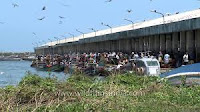Introduction
Neendakara is a small fishing village near the outskirts of Kollam Municipality. It is situated at a distance of 9 kilometers from the Kollam city on its northern side. The port in Neendakara has been regarded as the intermediate fishing port of the Kollam district in Kerala. The intermediate port is located approximately 30 kilometers north of Paravur another business point in Kollam district of Kerala in India. The word “Neendakara” seems to have originated from Malayalam word that translates exactly into “Long Bank” in the English language.
History of Neendakara
In the pre-independent India, first, the Portuguese settled down in Kollam district or pre-independent Quilon in the early part of the 16th century. They made the Tangaserry as their base. During this time, the ships bringing goods and merchandise used to pass by this place. Older people used to say that the Neendakara Bridge used to witness the passage of the ships towards the port. This is now part of the national highway 47 that connects Kanyakumari to Kochi. This bridge also connects the Neendakara village to Sakthikulangara through a water channel across the Ashtamudi Lake. Initially, small cargo handling used to happen in this port as well. Later, it was moved to the nearby Tangasseri port, near Saint Thomas fort at the time of the Dutch.
Importance in Trade
This port worked as the center or nodal point for the Indo-Norwegian Fisheries Community project since 1953 after India got independence. The project continued for eight years till the Kerala government took over it. As the port and the fishing hamlet were in thick of affairs before independence, the place became one of the prime locations for the establishment of ports in Kerala. Due to its strategic location in the East-West International Sea route for the international trade, the Neendakara port has retained its importance even after the coming of an operational port in Kochi. This busy sea route for international commerce is just 8 kilometers from the shore of Kollam in Kerala. Since the ancient times, the locals in that coastal hamlet have been in the fish trade. That is the reason the region has emerged as one of the prime fishing harbors in the whole of Kerala. As a result, many marine export-oriented businesses have come near this fishing hamlet along the National Highway 47. Now, people are moving to the Gulf countries to earn money quickly. As a result, the living conditions of the locals have improved to a large extent.
Demography
The majority of people in this fishing hamlet are Christians. The village also has a large number of Hindus and Muslims. But their number is lesser than that of Christians. As a result, a large number of Christian institutions have come up in its vicinity. One such building is that of the St. Sebastian Church. At present, this 500-year-old church belongs to the Diocese of Quilon. The celebration in this church is a big affair in this part of the world. The masses take out the idols of Saint Sebastian and Mother Mary in the business centers and the houses, and business establishments would be illuminated to welcome these idols.
Tourist Attractions
This beautiful place has also got some place in the tourist map of Kerala Tourism. In this blog, we would be looking at some of the reasons why it has earned its place in the Kerala tourism map.
- Bridge: The famous bridge that connects the two land masses near Shakthikulangara and provides the National Highway community is an attraction as it provides the best view of the delta formed by the opening of Ashtamudi Lake to the Arabian Sea.
- St. Sebastian Church: This church is visited by the believers every day. The festival at this church also draws a lot of people from different parts of Kollam and Thiruvananthapuram.
- Neendakara Beach: This is another attraction for the travelers to the Kollam district. This also would be the itinerary of South India-bound travelers from across the world and the country.










1 Post a Comment:
Worth Visiting Place
Post a Comment